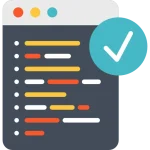Run
#include<stdio.h>
#define N 4
// This function returns 1 if A[][] and B[][] are identical
// otherwise returns 0
int areSame (int A[][N], int B[][N])
{
int i, j;
for (i = 0; i < N; i++)
for (j = 0; j < N; j++)
if (A[i][j] != B[i][j])
return 0;
return 1;
}
int main ()
{
int A[N][N] = { {1, 1, 1, 1},
{2, 2, 2, 2},
{3, 3, 3, 3},
{4, 4, 4, 4}
};
int B[N][N] = { {1, 1, 1, 1},
{2, 2, 2, 2},
{3, 3, 3, 3},
{4, 4, 4, 4}
};
if (areSame (A, B))
printf ("Matrices are identical ");
else
printf ("Matrices are not identical");
return 0;
}
Run
#include<bits/stdc++.h>
using namespace std;
#define N 4
// This function returns 1 if A[][] and B[][] are identical
// otherwise returns 0
int areSame (int A[][N], int B[][N])
{
int i, j;
for (i = 0; i < N; i++)
for (j = 0; j < N; j++)
if (A[i][j] != B[i][j])
return 0;
return 1;
}
int main ()
{
int A[N][N] = { {1, 1, 1, 1},
{2, 2, 2, 2},
{3, 3, 3, 3},
{4, 4, 4, 4}
};
int B[N][N] = { {1, 1, 1, 1},
{2, 2, 2, 2},
{3, 3, 3, 3},
{4, 4, 4, 4}
};
if (areSame (A, B))
cout<<"Matrices are identical";
else
cout<<"Matrices are not identical";
return 0;
}
Run
import java.util.*;
class Main
{
static int size=4;
public static boolean areSame(int A[][], int B[][])
{
int i,j;
for(i=0;i<size;i++)
{
for(j=0;j<size;j++)
if(A[i][j]!=B[i][j])
return false;
}
return true;
}
public static void main(String[] args)
{
int A[][]={{1,1,1,1},{2,2,2,2},{3,3,3,3,},{4,4,4,4}};
int B[][]={{1,1,1,1},{2,2,2,2},{3,3,3,3,},{4,4,4,4}};
if(areSame(A,B))
{
System.out.println("Matrices are identical");
}
else
System.out.println("Matrices are not identical");
}
}
Run
a = [[1,1,1,1],[2,2,2,2],[3,3,3,3],[4,4,4,4]]
b = [[1,1,1,1],[2,2,2,2],[3,3,3,3],[4,4,4,4]]
if a==b:
prin("Metrices are identical")
else:
pint("Metrices are not identical")





Question : 3 – Left Rotation
arr = [1,2,3,4,5]
def rotation_arr(arr, r):
for i in range(r):
poped_item = arr.pop(0)
arr.append(poped_item)
return arr
print(rotation_arr(arr, 4))
#QUESTION 3
#python code
n,d=list(map(int,input().split()))
l=list(map(int,input().split()))
for i in range(d):
x=l[0]
l.remove(l[0])
l=l+[x]
k=”
for i in l:
k=k+’ ‘+str(i)
k=(k).strip(‘ ‘)
print(k)
question 3 sollution:-
def de(a,k):
v=a[k:]
d=[]
s=””
for i in a:
if i not in v:
d.append(i)
for i in d:
v.append(i)
for i in v:
s=s+str(i)+” ”
return s.strip()
a=[41, 73, 89, 7 ,10, 1, 59, 58, 84, 77, 77, 97, 58, 1, 86, 58, 26, 10, 86 ,51]
k=10
print(de(a,k))